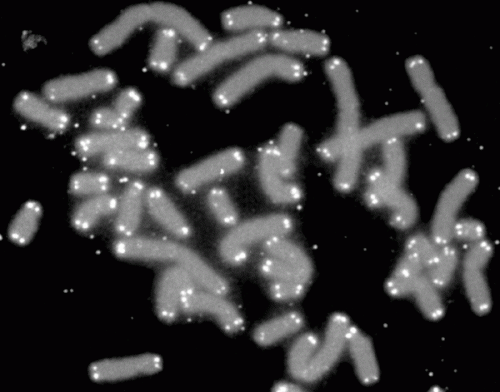An interesting fact is that the older cells are, the fewer times they can divide

In the last posts we discussed the topic of stopping aging. I wrote about the origin of the aging phenomenon, the different ideas on the subject, the free radicals and the telomeres.
or not. Sharp-eyed and sharp-thinking readers noticed that although I mentioned telomeres as a matter of course, I did not blog the entry about them. They are right, of course, and it is time to right the wrong.
the telomeres
An interesting fact is that the older cells are, the fewer times they can divide. Many of the cells in our body divide almost non-stop. Every hour each of us sheds between one and two million dead skin cells. To replenish the supply, the skin cells in the lower layer of the skin need to constantly divide and replenish the skin cell supply. If the cells age and stop dividing, one of the results is wrinkles in the skin and general deterioration of the body.
When we take cells from 90-year-old people and try to grow them in the lab, we find that they can divide a limited number of times. When we take cells from babies and grow them in the lab, we find that they can divide twice as many times. From this it can be concluded that the cells have a sort of molecular clock that tells them how many times they have already divided, and how much time they still have - and in elderly people the clock has almost run out.
The cells measure time using DNA sequences that are at the ends of the chromosomes and are called telomeres. You can think of them like the plastic edges that protect the laces on your shoes. At each division, the telomeres shorten a little. After many divisions there is not much left of the telomeres. At this stage, the DNA is unraveled, and a series of genes adjacent to the telomeres are revealed and are called 'peritelomeric genes' (that is, 'genes adjacent to telomeres' in Latin). The role of these genes is to paralyze some of the cell's activities - and among other things also the defenses against free radicals. The cell loses its defenses and is destroyed from the inside. And the more cells in the body reach their division limit and are destroyed, the more vulnerable the body is to heart, brain, infectious diseases and so on. That, at least, is the theory.
Are telomeres really responsible for cell aging? As an answer, we will examine the strange case of Henrietta Lex, who was hospitalized at the age of 31 with cervical cancer. Her picture gives me chills: she is young, confident and knows that the whole world is in front of her. It was like that, before the cancer attacked.

After Henrietta Lacks gave birth in 1951, she continued to feel a strange bulge in her stomach area. The doctor diagnosed a cancerous tumor the likes of which he had never seen before. He cut a piece of it and grew it in the lab. The cells grew, divided, divided again, and again and again and again. Today, they are still alive, more than sixty years after Henrietta Lex's death. If we had provided them with the proper environment to divide ad infinitum, within these sixty years their weight would have exceeded that of the entire earth.
Why is Henrietta Lex's story important to us? You probably guessed: the telomeres in Henrietta Lex's cells remained perpetually long. The cells acquired a mutation that causes the telomeres to be permanently re-lengthened, and thus gained eternal life.
Does this mean that the telomeres are also responsible for the aging process of the entire body? It is less certain, but there is interesting evidence on the subject. Children with some types of progeria, for example, are born with extremely short telomeres. Mice with similar progeria can be partially cured - rejuvenated, in fact - through genetic engineering that restores the length of their telomeres to their original length.
Most of us cannot yet benefit from genetic engineering due to the safety problems it necessarily encodes. But if you really long to return their telomeres to their original length, then you can order the food supplement TA-65 from the American company TA Sciences. This substance is extracted from the Chinese medicinal plant astragalus, and it is claimed that it helps activate the mechanism that lengthens the telomeres in humans. It is mildly stated that there is a need for plenty of additional research before these claims are fully verified. This fact does not prevent the company from selling their food supplement on the free market, at a cost ranging from 200 to 800 dollars per month. The company manager claims that he himself takes the preparation regularly every day.
intrested?
And here's the catch: telomeres play an important part in protecting the body from cancer. Almost all cancer cells in the body are mutant cells, which acquired a mutation that allowed them to re-extend their telomeres, and gain eternal cellular life. If we genetically engineer a person so that all of his cells can divide without limitation, he will be very vulnerable to cancer. This also happens in mice. There are no free meals.
This fact was re-validated following a lawsuit recently filed by one of the TA Sciences employees against the company's management. The employee, Brian Egan, was allegedly required to take the food supplement every day, so that he could tell customers wholeheartedly that he himself uses the preparation. After four months of use, Agan discovered that he had prostate cancer, and decided to sue the company for the damage caused to him. It must be admitted that even if the food supplement does perform the action attributed to it and lengthens the telomeres, it is hard to believe that in such a short time it was able to cause prostate cancer. And yet, the lawsuit reinforces the point on which biologists agree today: the shortening of telomeres serves an important purpose in protecting the body.
The solution?
If I had to put money on any direction for extending human life, I'd bet on a one-time 'start-up' of the mechanism that causes telomere re-lengthening. You can easily imagine such a treatment: a genetically modified virus, injected into the body, penetrates the cells and disables the brakes and stops that prevent the extension mechanism from operating. If the virus is designed correctly, then the instructions it contains will not integrate into the cellular DNA, so its effect will fade after a few days. In that short time the telomeres will return to their full length.
The danger of cancer in such a treatment will be minimal, because the brakes and restraints will be paralyzed only for a few days. And the yield? If the treatment bears fruit, and assuming that the telomere theory of aging is correct, then the people who undergo it should extend their lives significantly, and enjoy stronger protection against the general deterioration of the body.
Unfortunately, even if telomere shortening does play a role in aging, it is hard to believe that it is the only factor responsible for aging. We have already reviewed the possible role of free radicals in the process, and most likely many other factors contribute to the process. These may include:
– Injuries that harm the integrity of the body and force us to 'degenerate' at home in inaction and avoid physical activity;
- childhood diseases and 'mild' infectious diseases (see - 'the virus most of us carry, and takes four years of our lives');
- and diseases caused by the accumulation of harmful processes: Alzheimer's disease, sclerosis and narrowing of arteries leading to heart attacks and strokes.
All of these are just some of the possible causes of aging, and each of them will have to be dealt with separately. Sound discouraging? Certainly, but the research continues to be conducted with full vigor. Every year, hundreds of thousands of new biological studies are published, and the accumulated knowledge will allow us, in the end, to set up appropriate lines of defense against aging. There is no principled reason why we won't be able to win the war.
The only question is when.
More of the topic in Hayadan:
"Longevity" series by Dr.Roey Tsezana
Longevity - Part One: The Road to Eternal LifePart two - the evolution that killed me
To stop death - third part in the series, "longevity of life": the hunger for life
Longevity, Part 4 When Breathing Kills: Free Radicals and Aging
Keeping death at bay: the telomere theory. Fifth article in the longevity series

6 תגובות
Liz Parrish the deputy CEO of bioviva has undergone a genetic process since the article was written that lengthened her telomeres
I wanted to ask - I understand that an aging cell divides less and less. I asked: new cells are constantly being formed in these divisions, they are young and start the countdown again and if that is the case they are supposed to divide like a young cell. If so - where is the problem? Does an old cell divide into old cells like it?
According to what I understood, even a one-time 'start-up' of the telomeres could be dangerous since the cancer itself is a cell that has undergone a mutation that allowed it to develop and live forever, so the renewal of the telomeres could also lead to the creation of cancerous cells as a result of the process.
a one-time 'start-up' of the mechanism that causes the renewed extension of the telomeres; If the only factor responsible for aging is the telomeres.
It seems that long before we succeed in defeating all these diseases - we will succeed in doing a computer simulation of the human brain and move, as Prof. Yuval Neman said - to a more reliable platform for consciousness...
For those who are interested, a book about Henrietta Lex has been published and it has also been translated into Hebrew.
The writer "Rebecca Skloot", "The Eternal Life of Henrietta Lacks" translated from English: Naomi Carmel. Kinneret Publishing House, Zamora-Beitan. I read it, it gives more background about her as a young Negro woman in a fairly simple family whose life was not so easy in the United States.